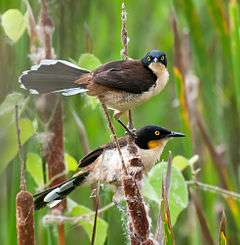Black-capped donacobius
| Black-capped donacobius | |
|---|---|
 | |
| In Piraju, São Paulo, Brazil Note lower bird displaying yellow neck patch | |
| Scientific classification | |
| Kingdom: | Animalia |
| Phylum: | Chordata |
| Class: | Aves |
| Order: | Passeriformes |
| Superfamily: | Sylvioidea |
| Family: | Donacobiidae (see text) |
| Genus: | Donacobius Swainson, 1831 |
| Species: | D. atricapilla |
| Binomial name | |
| Donacobius atricapilla (Linnaeus, 1766) | |
 | |
| All-year range | |
The black-capped donacobius (Donacobius atricapilla) is a conspicuous, vocal South American bird. It is found in tropical swamps and wetlands in Argentina, Bolivia, Brazil, Colombia, Ecuador, French Guiana, Guyana, Paraguay, Peru, Suriname, and Venezuela; also Panama of Central America.[1]
Taxonomy
%2C_dorsal_side_view.jpg)
The black-capped donacobius is the only member of the genus Donacobius. Its familial placement is not established, and ornithologists disagree as to its closest relations. In the 19th century, it was placed in the Turdidae, and in the 20th century, moved to the Mimidae. It had various English names, including the "black-capped mockingthrush". In the 1980s and 1990s, suggestions that it was a type of wren (Troglodytidae) were accepted by the South American Classification Committee (SACC), the American Ornithologists Union (AOU) and most other authorities. More recently, listing organizations and authors follow Van Remsen and Keith Barker's conclusion that it is not a wren either, but instead most closely related to an Old World (probably African) lineage.[2][3] A current proposal to the SACC would create a monotypic family, Donacobiidae, for this species, but this is not universally accepted as some authorities insist it may prove to be a member of an existing Old World family,[4] presumably the Locustellidae which seem to be its closest living relatives. These are long-tailed "warblers" from around the Indian Ocean region, many of which despite their cryptic coloration, smaller size and more solitary habits, are similar to the donacobius in stance, habitat and some aspects of their behavior (such as the nests); these "warblers" also have a similarly voice, but being higher-pitched they sound less grating and more like locusts (namely in Locustella).
Habitat
Black-capped donacobiuses are common in a wide range of Amazonian wetlands, including oxbow lakes, riparian zones, and other areas with tall dense aquatic or semi-aquatic vegetation. A third of the species range is outside the Amazon Basin, from Panama, northern Colombia, and western Venezuela, the Orinoco River system of Venezuela, to southeast coastal and inland Brazil, and neighboring countries southward, Paraguay, and extreme northern Argentina.
Behavior
Mating for life, pairs of black-capped donacobiuses can be seen frequently and throughout the day atop thickets of dense lakeside or streamside vegetation. They often will engage in antiphonic dueting. Adult offspring will remain with their parents and help raise siblings from subsequent nesting periods in a system of cooperative breeding.[3]
References
- 1 2 BirdLife International (2012). "Donacobius atricapilla". IUCN Red List of Threatened Species. Version 2013.2. International Union for Conservation of Nature. Retrieved 26 November 2013.
- ↑ Remsen, Van & Keith Barker (2004). "Proposal (#118) to South American Check-list Committee: Remove Donacobius from the Troglodytidae". Retrieved 2007-08-02.
- 1 2 "Donacobius page".
- ↑ Aleixo, Alexandre & J. F. Pacheco (2007). "Proposal (#293) to South American Classification Committee: Recognize Donacobius in its own family, Donacobiidae".
External links
- Black-capped Donacobius videos on the Internet Bird Collection
- Photo; Article sunbirdtours(Venezuelan species)
- Photo-Medium Res; Article chandra.as.utexas.edu
- Black-capped Donacobius photo gallery VIREO Photo-High Res
